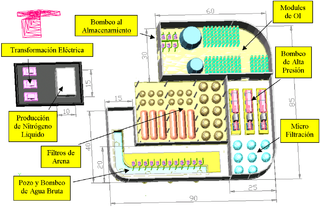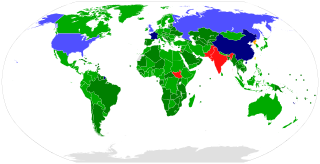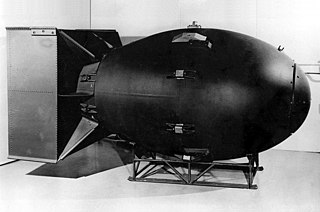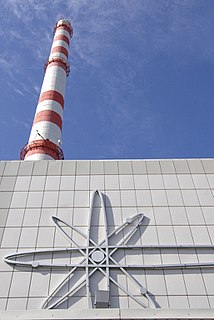Libya became a member of the IAEA in 1963.
Libya has a Soviet-designed 10 MWt research reactor in Tajura that was built 1981.

Tajura, also spelt Tajoura, is a town in north-western Libya, and baladiyah in the Tripoli Muhafazah, on the Mediterranean coast 14 kilometres (8.7 mi) east of Tripoli.
In the late 1970s Libya signed a contract with the Soviet nuclear company Atomenergoexport for two VVER-440 reactors, each delivering 440 MW [1] [2] of electrical power on the Gulf of Sirte. The reactors were intended to serve a dual-use for electric power generation and seawater desalination. [3] As Libya was discontented with the technology the USSR wanted to provide them with, the Belgian nuclear company Belgonucleaire was asked to take over the contract. However, due to objection from the United States for concerns regarding misuse of nuclear weapons development, Belgonucleaire refused and Libya asked the USSR again. In the end, the project was stopped during its planning phase in 1986. [4] [5]

The water-water energetic reactor (WWER), or VVER is a series of pressurised water reactor designs originally developed in the Soviet Union, and now Russia, by OKB Gidropress. VVER were originally developed before the 1970s, and have been continually updated. As a result, the name VVER is associated with a wide variety of reactor designs spanning from generation I reactors to modern generation III+ designs. Power output ranges from 70 to 1200 MWe, with designs of up to 1700 MWe in development.

Gulf of Sirte, or Gulf of Sidra after the port of Sidra, is a body of water in the Mediterranean Sea on the northern coast of Libya. Historically it has been also known as the Great Sirte or Greater Syrtis.

Desalination is a process that takes away mineral components from saline water. More generally, desalination refers to the removal of salts and minerals from a target substance, as in soil desalination, which is an issue for agriculture.
In 2006 Libya and France signed an agreement on peaceful uses of atomic energy, [6] and in July 2007, they signed a memorandum of understanding related to building a mid-sized nuclear plant with Areva reactor for seawater desalination. This deal was opposed by Germany. [7] This was followed by a memorandum with Canada, to share nuclear medicine, desalinization technology and co-operation over nuclear energy research. [8]

Libya, officially the State of Libya, is a country in the Maghreb region in North Africa, bordered by the Mediterranean Sea to the north, Egypt to the east, Sudan to the southeast, Chad to the south, Niger to the southwest, Algeria to the west, and Tunisia to the northwest. The sovereign state is made of three historical regions: Tripolitania, Fezzan and Cyrenaica. With an area of almost 1.8 million square kilometres (700,000 sq mi), Libya is the fourth largest country in Africa, and is the 16th largest country in the world. Libya has the 10th-largest proven oil reserves of any country in the world. The largest city and capital, Tripoli, is located in western Libya and contains over one million of Libya's six million people. The second-largest city is Benghazi, which is located in eastern Libya.

France, officially the French Republic, is a country whose territory consists of metropolitan France in Western Europe and several overseas regions and territories. The metropolitan area of France extends from the Mediterranean Sea to the English Channel and the North Sea, and from the Rhine to the Atlantic Ocean. It is bordered by Belgium, Luxembourg and Germany to the northeast, Switzerland and Italy to the east, and Andorra and Spain to the south. The overseas territories include French Guiana in South America and several islands in the Atlantic, Pacific and Indian oceans. The country's 18 integral regions span a combined area of 643,801 square kilometres (248,573 sq mi) and a total population of 67.3 million. France, a sovereign state, is a unitary semi-presidential republic with its capital in Paris, the country's largest city and main cultural and commercial centre. Other major urban areas include Lyon, Marseille, Toulouse, Bordeaux, Lille and Nice.
In 2010 Libya confirmed that it intended to create a nuclear energy sector. [9]













